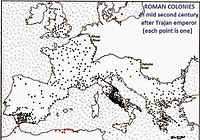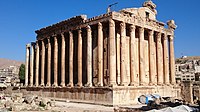Colonia Ulpia Traiana


Vetera II
Colonia Ulpia Traiana (sometimes called "Castra Vetera") was a colonia in the Roman province of Germania inferior, founded by emperor Trajan.[1] It was located in the area of today's Xanten.
History
First camp
First settlements in the area by isolated tribes can be dated around the year 2000 BC. Around 15 BC the Roman castrum (legio camp) was created near modern-day Birten, not far away from the Rhine river. It was intended as a base for campaigns into Germania, and until its destruction during the Revolt of the Batavi in 70 AD, it was occupied by 8,000 to 10,000 legionnaries.


It was also called "Castra Vetera", and was the main base of the Classis Germanica, because it used an inlet (now called "Bislicher insel") created by the old course of the Rhine river. The headquarters of this Classis were established in 12 BC by Drusus[2] and controlled the Rhine river: it was mainly a fluvial fleet, although it also operated in the North Sea. After 30 AD, the fleet moved its main base to the castrum of Alteburg, some 4 km south of Colonia Claudia Ara Agrippinensium (modern Cologne).[3].
Second camp
After the destruction of Vetera a second camp became established inside the river inset, named Castra Vetera II, which became the base camp of Legio VI Victrix. The actual name of the local small city of Birten comes from the "germanization" of the pronunciation of the latin word "Vetera".
Colonia
A few decades later a nearby created settlement, which was inhabited by 10,000 to 15,000 former legionnaries with their families and others (mainly German & Celtic civilians in the canabae), was given the rights of a colonia: in 110 AD the Roman emperor Marcus Ulpius Traianus renamed the town Colonia Ulpia Traiana. He gave his own name to the settlement and elevated the city to the privileges of the status of "Roman colonia" (that only other 150 cities in the Roman empire obtained).
The colonia was a completely new town with a defensive huge wall and other important buildings, like an amphitheater. For this town the old castrum settlement was completely abandoned. The colonia became the second most important commercial post in the province of Germania Inferior, surpassed only by Colonia Agrippinensis (today's Cologne). In 122 AD, Vetera II became the camp of Legio XXX Ulpia Victrix, replacing VI Victrix which had moved to Britannia. Colonia Ulpia Traiana was defended by huge walls long 3.4 km and with 22 towers[4]
During the whole 2nd and the first half of the 3rd century this Roman colony was involved into a continuing process of urbanization and architectural improvement. The Roman Baths were built by Hadrian around 125 AD, with a big Port Temple.[5] But the huge complex of Thermae (that comprised hot, warm and cold baths, changing rooms, and saunas) was destroyed in 275 AD.
Recent archaeological excavations in the area of the Capitolium-temple, Harbor-temple, Roman Baths and Forum brought numerous fragments of veneering slabs of marble to light, which once lavishly decorated walls and floors of these publish buildings.


In 275 AD the colonia was almost destroyed by Germanic tribes. Subsequently, in 310 AD in the area of the colonia a new town was established, named Tricensimae ("of the Thirtieth"), which was built on the nine central insula of the former colonia but fortified and more easily defended.
However at the beginning of the fifth century, assaults by Germanic tribes (mainly the Franks) rapidly increased, with the result that Tricensimae was finally given up.
Meanwhile in 363 AD, during the reign of Julian, the Christian Viktor of Xanten is supposed to have been executed together with 360 other members of the Theban Legion near the modern town of Birten for refusing to sacrifice to the Roman gods. Considered a martyr and a saint by the Roman Catholic Church as well as the Eastern Orthodox Church, Viktor of Xanten is commemorated in Xanten Cathedral, where his relics are kept in a shrine embedded in the high altar.
Post-Roman era
Around 440 AD the city was definitively abandoned by the Roman Empire, who moved most of the remaining inhabitants to the area of Augusta Treverorum.[6] In the second half of the fifth century, the Franks began to settle in the area (mixing with the small surviving Romanized population), but no urban settlements have been found from this time as the Franks did not build in stone, unlike the Romans.
In the second half of the 8th century a church was built on the grounds of an old cemetery of the ancient Roman colony and called Sanctos (super Rhenum) (also mentioned as "Ad Sanctum"). The name of "place of saints" was derived from the assumed grave of the martyr Viktor of Xanten and is the source of today's municipal name of Xanten.
An "Archaeologischer Park" (archeological park) with a reconstructed amphitheater was established in the place where Colonia Ulpia Traiana existed.[7]
Gallery
-
 Rebuilt Amphiteater in the "Archaeologischer Park"
Rebuilt Amphiteater in the "Archaeologischer Park" -
 Actual Stadium in rebuilt Amphiteater
Actual Stadium in rebuilt Amphiteater -
 2003 "Romerfest" in "Stadium" of rebuilt Amphiteater
2003 "Romerfest" in "Stadium" of rebuilt Amphiteater -
 Thermae section
Thermae section -
 Heating system in Roman buildings
Heating system in Roman buildings -
 Thermae floor tiles
Thermae floor tiles -
 Model of the Roman Baths
Model of the Roman Baths -
 Rebuilt "Harbor Temple" in the "Archaeologischer Park"
Rebuilt "Harbor Temple" in the "Archaeologischer Park" -
 Remains of "Basilica"
Remains of "Basilica" -
 Pliny the Elder's inscribed phalera
Pliny the Elder's inscribed phalera -
 Roman walls in the "Archaeologischer Park"
Roman walls in the "Archaeologischer Park" -
 Small Gate in the "Archaeologischer Park"
Small Gate in the "Archaeologischer Park" -
 Temple of the Matrons (excavation))
Temple of the Matrons (excavation)) -
 Corn Mill (reconstruction)
Corn Mill (reconstruction) -
 Main Gate in the Archaeologischer Park"
Main Gate in the Archaeologischer Park" -
 Aqueduct in the "Archaeologischer Park"
Aqueduct in the "Archaeologischer Park" -
 Porticus of reconstructed Roman house
Porticus of reconstructed Roman house -
 Reconstructed "Triclinum"
Reconstructed "Triclinum" -
 Reconstructed mansion bedroom
Reconstructed mansion bedroom -
 Reconstructed Roman kitchen
Reconstructed Roman kitchen -
 Gravestone of equites "Reburrus"
Gravestone of equites "Reburrus"
See also
- Colonia Ulpia Traiana Horse-Phalerae
- Colonia Claudia Ara Agrippinensium
- Germania inferior
- Augusta Treverorum
Notes
Bibliography
- Cleere, Henry (1977), "The Classis Britannica (and Germanica)" (PDF), CBA Research Report (18): 16–19
- Ohlig,Christoph. Die Wasserleitung zur Colonia Ulpia Trajana. Deutsche Wasserhistorische Gesellschaft, Siegburg 2007, ISBN 978-3-8334-8433-9,
- Otten, Thomas. Colonia Ulpia Traiana. Xanten und sei Umland in römischer Zeit. Editorial Müller. Maguncia, 2008 ISBN 978-3-8053-3953-7
- von Petrikovits, Harald (1976). "Vetera and Colonia Ulpia Traiana (Birten and Xanten) Kreis Moers, Germany". In Stillwell, R.; MacDonald, W.L.; McAllister, M.H. (eds.). The Princeton Encyclopedia of Classical Sites. Princeton University Press. ISBN 978-0-691-03542-0. Retrieved 2024-06-07.
- Webster, Graham. The Roman Imperial Army of the First and Second Centuries AD, University of Oklahoma Press. Oklahoma, 1998 ISBN 0-8061-3000-8
- v
- t
- e
| Britannia Superior | |
|---|---|
| Britannia Inferior | |
| Roman Dacia | |
| Gallia Lugdunensis | |
| Gallia Narbonensis | |
| Germania Inferior | |
| Hispania | |
| Italia | |
| Moesia |


| Of legion veterans | |||||||||||
|---|---|---|---|---|---|---|---|---|---|---|---|
| Of late Empire |
| ||||||||||
| Possible colonies | |||||||||||
| Locations with modern names |
|
- 1 UNESCO World Heritage Sites; 2 Proposed; 3 in Danger
- See also: Legacy of the Roman Empire
































